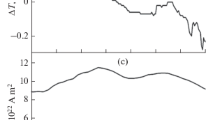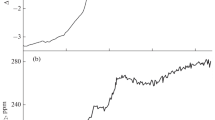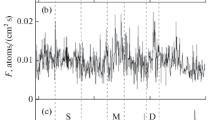Abstract
The results of reconstruction of the heliospheric modulation potential based on radiocarbon data for the time interval 17 000–5000 years B.C. are presented. The considered time interval includes the epochs of the end of the Last Ice Age, the Early and Middle Holocene. Factors affecting the change in the radiocarbon content in the studied samples were taken into account in this reconstruction: the time variation of the global temperature, the change in the Earth’s magnetic field, the increase in the CO2 concentration in the Earth’s atmosphere during the retreat of glaciation, and changes in vegetation in the Early Holocene. The maximum in 12 380 years B.C., which might correspond to the high activity of the Sun, is notable among the extremes of the modulation potential. Raised values of the heliospheric modulation potential were observed for several hundred years and coincided in time with the Mayendor warming period on Earth.



Similar content being viewed by others
REFERENCES
Cuffey, K.M., Clow, G.D., Alley, R.B., et al., Large Arctic temperature change at the Wisconsin–Holocene glacial transition, Science, 1995, vol. 270, pp. 455–458.
Cuffey, K.M., Clow, G.D., Steig, E.J., et al., Deglacial temperature history of West Antarctica, Proc. Natl. Acad. Sci., 2016, vol. 113, no. 50, pp. 14 249–14 254.
Knudsen, M.F., Riisager, P., Donadini, F., et al., Variations in the geomagnetic dipole moment during the Holocene and the past 50 kyr, Earth Planet. Sci. Lett., 2008, vol. 272, pp. 319–329.
Koudriavtsev, I.V., Dergachev, V.A., Nagovitsyn, Yu.A., et al., On the influence of climatic factors on the ratio between the cosmogenic isotope 14C and total carbon in the atmosphere in the past, Geohronometria, 2014, vol. 41, no. 3, pp. 216–222.
Kovaltsov, G.A., Mishev, A., and Usoskin, I.G., A new model of cosmogenic production of radiocarbon 14C in the atmosphere, Earth Planet. Sci. Lett., 2012, vols. 337–338, pp. 114–120.
Kudryavtsev, I.V. and Dergachev, V.A., Radiocarbon data: Reflection of solar activity variations and biospheric changes in Early Holocene, Trudy Vserossiiskoi ezhegodnoi konferentsii po fizike Solntsa “Solnechnaya i solnechno-zemnaya fizika-2016” (Proceedings of the All-Russian Conference on Solar Physics “Solar and Solar–Terrestrial Physics-2016”), St. Petersburg: GAO RAN, 2016, pp. 179–182.
Kudryavtsev, I.V., Volobuev, D.M., Dergachev, V.A., et al., Reconstructions of the 14C cosmogenic isotope content of natural archives after the last glacial period, Geomagn. Aeron. (Engl. Transl.), 2016, vol. 56, no. 7, pp. 858–862.
Kudryavtsev, I.V., Volobuev, D.M., Dergachev, V.A., et al., Reconstruction of the production rate of cosmogenic 14C in the Earth’s atmosphere for 17000–5000 BC, Geomagn. Aeron. (Engl. Transl.), 2018, vol. 58, no. 7, pp. 925–929.
Marcott, S.A. and Shakun, J.D., Holocene climate change and its context for the future, Pages Mag., 2015, vol. 23, no. 1, p. 28.
Marcott, S.A., Shakun, J.D., Clark, P.U., and Mix, A.C., A reconstruction of regional and global temperature for the past 11,300 years, Science, 2013, vol. 339, pp. 1198–1201.
Monnin, E., Indermuhle, A., Dallenbach, A., et al., Atmospheric CO2 concentrations over the last glacial termination, Science, 2001, vol. 291, pp. 112–114.
Poluianov, S.V., Kovaltsov, G.A., Mishev, A.L., and Usoskin, I.G., Production of cosmogenic isotopes 7Be, 10Be, 14C, 22Na, and 36Cl in the atmosphere: Altitudinal profiles of yield functions, J. Geophys. Res.: Atmos., 2016, vol. 121, pp. 8125–8136.
Reimer, P.J., Bard, E., Bayliss, A., et al., IntCal13 and MARINE13 radiocarbon age calibration curves 0–50 000 years calBP, Radiocarbon, 2013, vol. 55, no. 4, pp. 1869–1887.
Shakun, J.D., Clark, P.U., He, F., et al., Global warming preceded by increasing carbon dioxide concentrations during the last deglaciation, Nature, 2012, vol. 484, pp. 49–55.
Svensson, A., Andersen, K.K., Bigler, M., et al., A 60 000 year Greenland stratigraphic ice core chronology, Clim. Past, 2008, vol. 4, pp. 47–57.
Author information
Authors and Affiliations
Corresponding authors
Ethics declarations
There is no conflict of interest by the authors of this work.
Rights and permissions
About this article
Cite this article
Kudryavtsev, I.V., Dergachev, V.A. Reconstruction of Heliospheric Modulation Potential Based on Radiocarbon Data in the Time Interval 17 000–5000 Years B.C.. Geomagn. Aeron. 59, 1099–1102 (2019). https://doi.org/10.1134/S0016793219080115
Received:
Revised:
Accepted:
Published:
Issue Date:
DOI: https://doi.org/10.1134/S0016793219080115




